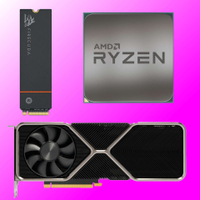AMD's FSR 3.1 finally arrives, sporting an improved upscaler for less ghosting, flickering, and shimmering in games
The frame generation algorithm is also now fully decoupled to allow older Nvidia RTX and Intel Arc cards to use it with their DLSS and XeSS upscalers.
Three months after officially announcing the 3.1 update to its FidelityFX Super Resolution (FSR) technology suite, five games from Sony have all been patched to the new system. Ghost of Tsushima, Horizon Forbidden West, Ratchet and Clank: Rift Apart, and the two Spider-Man games now sport an improved shader-based upscaler and decoupled frame generation so that more PC gamers can enjoy the same boost in performance, but with better-looking results than before.
When AMD announced its third generation of FidelityFX Super Resolution (FSR) with its Radeon RX 7000-series GPU launch in November 2022, many PC gamers hoped that it would include an upgrade upscaler but it transpired that FSR 3.0's only new feature was a shader-based frame generation system.
The FSR 2.2 upscaler was still being used and while it does a serviceable job, in terms of increasing frame rates, its visual quality could be noticeably worse than Nvidia's DLSS Super Resolution in some games.
That's the first big change in FSR 3.1 as AMD has improved its shader algorithm for the upscaler, claiming that it has "improved temporal stability, reducing flickering and shimmering, and enhanced ghosting reduction and better detail preservation" than the old system.
On its blog announcing the public launch of the update, AMD has a short comparison video of FSR 2.2 and FSR 3.1, but tech YouTuber Daniel Owen has done a more in-depth look, comparing the new system to Nvidia's DLSS.
In Ratchet and Clank: Rift Apart, the improvements are very clear to see, or rather, where the older upscaler struggled, the new one is markedly better. You're not getting any additional performance as such, just far less flickering and shimmering where you've got an object rapidly moving or characters with lots of fur on them.
Something else that FSR 3.1 brings to the table is a decoupled frame generator. In FSR 3.0, you could only use AMD's frame interpolator with its shader-based upscaler. One of the first games to roadtest the separation of the two was Ghost of Tsushima, allowing graphics cards such as Nvidia's RTX 30-series and Intel's Arc range to run their own upscalers but with AMD's frame generator.
The biggest gaming news, reviews and hardware deals
Keep up to date with the most important stories and the best deals, as picked by the PC Gamer team.
Now that FSR 3.1 has been fully released, four more games have been patched to follow suit—Horizon Forbidden West, the aforementioned Ratchet and Clank, Spider-Man Remastered, and Spider-Man: Miles Morales. At some point very soon, the port of God of War: Ragnarok will also get updated to the new version.
AMD has streamlined the FSR software package for developers and added support for Vulkan and the Xbox platform, so we should hopefully see FSR 3.1 being used in all forthcoming game releases. The SDK for the updated tech will be publicly released next month so we should be able to see what changes AMD has implemented under the hood of its upscaler to improve the visual quality of the system.
Best CPU for gaming: Top chips from Intel and AMD.
Best gaming motherboard: The right boards.
Best graphics card: Your perfect pixel-pusher awaits.
Best SSD for gaming: Get into the game first.

Nick, gaming, and computers all first met in 1981, with the love affair starting on a Sinclair ZX81 in kit form and a book on ZX Basic. He ended up becoming a physics and IT teacher, but by the late 1990s decided it was time to cut his teeth writing for a long defunct UK tech site. He went on to do the same at Madonion, helping to write the help files for 3DMark and PCMark. After a short stint working at Beyond3D.com, Nick joined Futuremark (MadOnion rebranded) full-time, as editor-in-chief for its gaming and hardware section, YouGamers. After the site shutdown, he became an engineering and computing lecturer for many years, but missed the writing bug. Cue four years at TechSpot.com and over 100 long articles on anything and everything. He freely admits to being far too obsessed with GPUs and open world grindy RPGs, but who isn't these days?

The TDP of the Nvidia GeForce RTX 5090 and 5080 have been leaked, suggesting it's a little less power-hungry than we thought, though still massive

Nvidia is giving away 5 classic Jensen-signed GeForce cards if you tweet to build hype for its CES 2025 briefing, and its first choice is almost older than me
Most Popular







